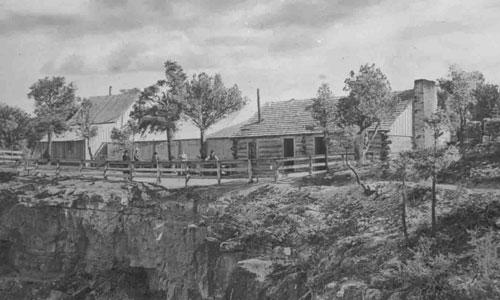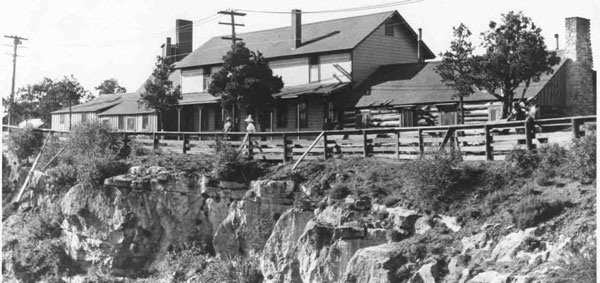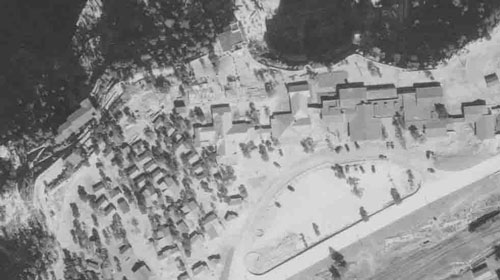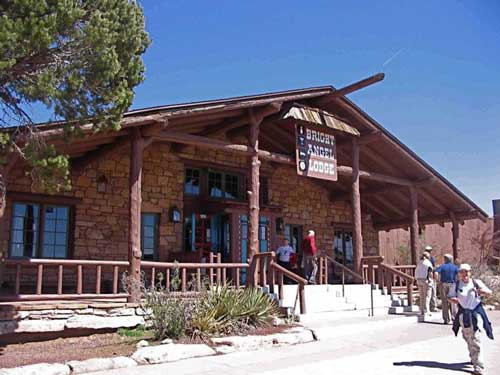In the earliest days of Grand Canyon tourism, visitors approached the South Rim by foot, horse, wagon, or stage and camped in the wild for the length of their stay. By the early 1890s, tourists had options for a slightly more comfortable visit.
William Bass offered meager rooms or a tent nearly 25 miles west of the Bright Angel Trail at Pasture Wash. Pete Berry advertised comfortable hotel rooms or tent cabins near the rim at Grandview, 15 miles east of the Bright Angel trail. John Hance supplied tents for his customers only three miles east of Grandview while James Thurber and J.H. Tolfree soon leased Hance’s facilities and upgraded services, if not their tents.
Visitors seemed to favor Berry’s establishment, but most found little advantage to staying at one of these widely separated pioneer camps over the others, and each entrepreneur enjoyed a more or less equal market share of tourist dollars.
By the late 1890s it seemed inevitable that a railroad would soon reach the South Rim; it was only a question of when and where, and how soon those establishments left far from the rimside railroad depot would die. Getting a jump on potential competition, James Thurber extended the Flagstaff-Grand Canyon stage line from his enterprise near Grandview to an entirely new location, the very head of the Bright Angel Trail, in 1896, and in the same year built a small frame structure here that he named the Bright Angel Hotel.
At about the same time, Buckey O’Neill, who would form the railroad company that would start laying tracks from Williams within a few years, and therefore chose the railroad’s destination, built a log cabin immediately west of Thurber’s establishment and named it O’Neill’s Camp. Thurber acquired O’Neill’s cabin shortly before or immediately after O’Neill died fighting in Cuba in 1898.
Thurber erected a circus tent between the two structures (soon replaced by another framed building), added tents in neat rows south of the facility, and ran the entire operation as the Bright Angel Hotel and Bright Angel Camps. These first, simple accommodations at the Bright Angel Trailhead became the nucleus for a new town, Grand Canyon Village.
In early 1901 James Thurber sold the Bright Angel Hotel to Martin Buggeln, who already ran a hotel in Williams and looked forward to the railroad that would arrive at his rimside doorstep in September of that year. Neither Thurber nor Buggeln thought to make a formal claim to the land on which their hotel stood, so when the Grand Canyon Railway arrived, its owner, the Atchison, Topeka & Santa Fe Railway, platted its 20-acre depot site to encompass the Bright Angel Hotel as well as a goodly portion of the near rim and Bright Angel Wash to the south. The railroad and Buggeln worked cooperatively to service a growing number of tourists in the early years of the century while the railroad built its upscale El Tovar Hotel. When El Tovar was completed in early 1905, the railroad bought out Buggeln’s interests in the Bright Angel, upgraded the facility for middle-class visitors, and replaced Buggeln’s tents with well-furnished, heated, tent cabins.
With solid financial backing, quality facilities and tasty meals, the Bright Angel Hotel soon ran yet another nearby competitor—Cameron’s Hotel and Camps (1903-1907)—out of business. Visitors arriving by train ambled up the hill to the rimside hotel while porters fetched their baggage. The refurbished main building offered eight guest rooms and a roomy reception area with a large fireplace, Navajo rugs, rocking chairs, and a piano. Guests could also stay in a six-room frame annex or in one of the well-appointed tent cabins. The hotel provided good meals, riding stock, and guides, charging two to three dollars per night for overnight accommodations, three dollars for a horse, and five dollars for a guide (compare that to today’s prices, understanding that one dollar a century ago would be worth about 25 dollars today).
As Grand Canyon Village grew, the Bright Angel Hotel served its middle-class guests well during the years 1896-1935, but by the early 1930s, the facility and its utilities had become somewhat aged and unsightly after forty years of structural additions.
The Atchison, Topeka & Santa Fe Railway asked architect Mary Colter to begin designs for a replacement facility in the middle 1920s, but not until 1934 did railway managers approve and finance Colter’s final plans for a replacement Bright Angel Lodge and associated cabins.
Colter saved the Red Horse and Buckey O’Neill cabins because of their historical value. Her final design for sturdier new cabins to replace earlier tent cabins blended elements of hewn and peeled logs, with the logs adzed in a decorative pattern of stone, board and batten, and pueblo-style adobe. The result was imaginative architecture within the National Park Service Rustic Style, harmonious with past and local settings.
Colter built a six-foot long model of the complex, in which not only each cabin, but every tree and bush was illustrated so that interrelationships could be studied in detail. It was not only the individual designs that were important to Colter, but how they related to each other visually, how they were sited, and how they related to the local environment.
Today’s Bright Angel Lodge opened to the public on July 22, 1935. An article in The Hotel Monthly in December 1936, mentions that:
… extraordinary pains were taken to preserve the trees and the native shrubs and flowers. Also that most of the buildings are linked with pergolas, or covered ways … The plat of Bright Angel Lodge and Cabins…has back of it a most unusual story. It was first designed to scale in toy form by Miss M.E.J. Colter, the toy covering a table over 6 feet long, every building shown on the plat fashioned in the particular style of architecture, and colored to show the stone, weathered logs or adobe of its construction; and every tree was also shown in the model.
Such attention to detail was a hallmark for Mary Colter’s work, one reason that no structure designed by Colter, erected by the Santa Fe, and managed by the Fred Harvey Company at Grand Canyon has ever been torn down. Several additions to the central services building (the soda fountain and Arizona Steak House to the east) were made in succeeding years in a style sympathetic to Colter’s, but the lodge’s main building and all of the eclectic cabins designed by Colter still complement the landscape in the heart of the Grand Canyon Village. The lodge, along with many of the village’s other early buildings, is now listed on the National Register of Historic Places.
Written By Micheal F. Anderson
References:
- Anderson, Michael F. Living at the Edge: Explorers, Exploiters and Settlers of the Grand Canyon Region. Grand Canyon Association, 1998.
- Anderson, Michael F. Polishing the Jewel: An Administrative History of Grand Canyon National Park. Grand Canyon Association, 2000.
- Grattan, Virginia L. Mary Colter: Builder Upon the Red Earth. Grand Canyon Association, 1992.
- Zeman, Amanda, and Anderson, Michael F., and Quinn, Michael. “Bright Angel Trailhead Historical Landscape Evaluation.” NPS Report, February 23, 2006.





